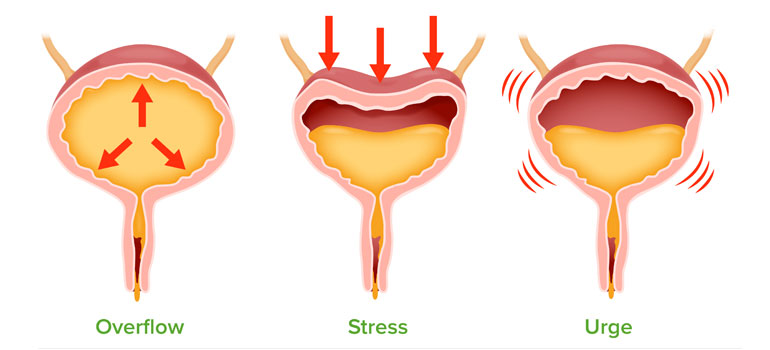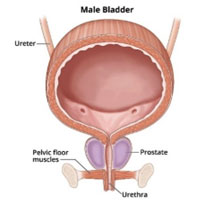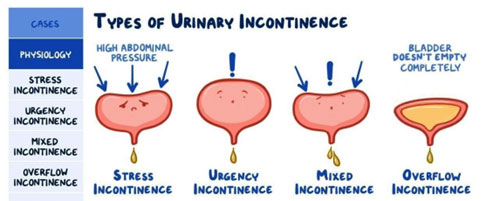
The experience of uncontrollably leaking urine can be an embarrassing issue for many people. Urinary incontinence is a loss of bladder control that’s commonly seen in older adults and women who have given birth or gone through menopause. Urinary tract infections (UTIs), pelvic floor disorders and an enlarged prostate are other causes.

There are several different types of incontinence. These types have different causes, characteristics and triggers for urine leakage. Knowing the type of incontinence is often an important part of the diagnosis and treatment plan for incontinence.

Urge incontinence: This type of incontinence is characterized by an intense need to urinate right away. Often, this happens too quickly for you to make it to a toilet and you end up leaking urine. Urge incontinence can be caused by a condition called overactive bladder (OAB). You could have OAB for a variety of reasons like having weak pelvic muscles, nerve damage, an infection, low levels of estrogen after menopause or a heavier body weight. Some medications and beverages like alcohol and caffeine can also cause OAB.
Causes:
The following causes of urge incontinence have been identified:
Stress incontinence: When you leak urine during activities, this is often stress incontinence. In this type of incontinence, your pelvic floor muscles are weak and no longer support your pelvic organs as they should. This muscle weakness means that you’re more likely to accidently leak urine when you move around. For many people, leakage issues happen when they laugh, cough, sneeze, run, jump or lift things.
These actions all place pressure on your bladder. Without the support of strong pelvic muscles, you’re more likely to leak urine. Women who have given birth are at a higher risk of having stress incontinence. Men who have had prostate surgery may develop stress incontinence.
Causes:
Overflow incontinence: If your bladder doesn’t empty completely each time you urinate, you could have overflow incontinence. Think of the bladder as a juice jug. If you only pour some of the juice out of the jug, but not all of it, there’s still a risk that you could spill when you move around. People with overflow incontinence never completely empty the bladder — placing them at risk for a spill. Usually, this results in small amounts of urine dripping out over time instead of one big gush of urine.
This type of incontinence is more common in people with chronic conditions like multiple sclerosis (MS), stroke or diabetes. This may also occur in men with a large prostate.
Causes:
This happens when there is an obstruction or blockage to the bladder. The following may cause an obstruction:
Mixed incontinence: This type of incontinence is a combination of several problems that all lead to leakage issues. When you have mixed incontinence, you might be dealing with stress incontinence and an overactive bladder. It’s often important to pay attention to what you’re doing when you have leakage issues with this type of incontinence. Identifying what triggers mixed incontinence is usually the best way to manage it.
Causes:
Other Causes:
Treatment will differ depending on the type of incontinence, age, level of health and mental state of the patient.
